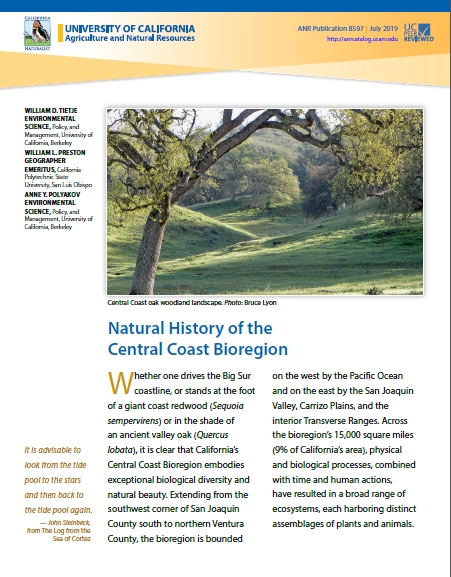Descriptions of California's Central Coast often include terms like beautiful, bucolic and idyllic. These elated opinions are understandable. The region is blessed with a varied topography, pleasant climate, spectacular views, and a splendid array of natural ecosystems. So whether you are interested in rare and endangered species such as the California condor, or the species diversity found in tide pools or oak woodlands, the California Central Coast is a great place to begin your tour.

It's a reader's digest and road map designed to stimulate and educate the curious to learn more and to become actively engaged in sustaining the region's biological legacy. The narrative is supported with several diagrams and maps and 65 photographs. Additionally, the work is laced with 12 vignettes that provide attention and detail to noteworthy topics. Eleven of these include renditions of historical figures and events, animal and plant ecology, environmental challenges, and conservation measures (examples include uplifting stories about condors, elephant seals, the Carmel River, and the Monterey Bay National Marine Sanctuary). The 12th and final vignette consists of a map accompanied by short descriptions of fascinating places to visit that are particularly expressive of the bioregion's natural and cultural history.
Those interested in a substantive, yet readable portrayal of the natural history of the Central Coast need look no further. A free download is available from the online UC ANR Catalog https://anrcatalog.ucanr.edu/Details.aspx?itemNo=8597.
Education programs for interested public and students on the Central Coast's natural history are offered at many of the locations discussed in the Central Coast bioregion publication. Examples include the Monterey Bay Aquarium. The aquarium hosts a Discovery Lab where visiting students receive hands-on instruction on many of today's environmental challenges.
The Elkhorn Slough Coastal Training Program in Watsonville offers science-based information on Central Coast flora and fauna, and issues involving coastal watersheds. Sept. 20-22, 2019, the Elkhorn Slough Reserve will host the Monterey Bay Birding Festival. The festival features a variety of birding tours and workshops that will be held at the reserve, Big Sur, and Pinnacles National Park. Lessons on bird photography and bird carving are available. For complete descriptions of field trips and workshops and to register the Monterey Bay Birding Festival website.
The Santa Barbara Botanic Garden hosts UC's California Naturalist Program. CalNat instructs citizen scientists on the natural history and conservation of terrestrial and aquatic habitats. There are upcoming California Naturalist courses at the three CalNat partner organizations in the Central Coast Bioregion: Cuesta College, Camp Ocean Pines, and the Santa Barbara Botanic Garden. For certification, Natural History of the Central Coast Bioregion is a required reading. As a certified California Naturalist, you will provide voluntary service that helps to sustain Central Coast biodiversity. To learn more, visit http://calnat.ucanr.edu/.